Blog Summary: Are you looking to build a cutting-edge AI application that achieves maximum accuracy and has widespread application? Look no further because our latest blog, “Top 9 AI Development Platforms for AI Applications 2025,” will solve all your ambiguity. It’ll help you explore the best platforms and tools for developing AI applications that boost your business ROI and empower it. Let’s jump in and find the perfect top platforms for AI App development.
Introduction to AI Development Platforms
Did you know? According to research, the AI platform market is experiencing strong growth and is projected to rise from USD 18.22 billion in 2025 to over USD 94.30 billion by 2030. (Source: Markets and Markets) Artificial Intelligence has been revolutionary and gained popularity over the past decades— the reason? It is a perfect consolidation of 3 major factors: technological breakthroughs, the availability of data, and practical, widespread application.
AI development platforms have been the backbone of all these initiatives and one of the best AI trends. For instance, Toyota utilises Google Cloud AI infrastructure to launch a factory AI platform for machine learning models. At the same time, Paytm leverages Microsoft GitHub Copilot (integrated with Azure) to launch their code armor. AI app development platforms are massive ecosystems that simplify the complex process of building, deploying, and scaling AI applications. The right knowledge and assistance can help you find the best AI development platforms for your AI applications.
What Are AI Development Platforms?
AI development Platforms are huge integrated ecosystem that offers specialised software, tools, or platforms to help streamline the creation, training, execution, and management of AI models and applications. Overall, it’s like a treasure trove you can find all the valuable things for your project.
So, it is an ultimate toolkit or one-stop shop for developers, data scientists, and businesses, offering pre-built tools, systems, libraries, and infrastructure to accelerate the AI development process. For instance, a practical AI use cases could be a small business owner using an AI development platform like Google Cloud AI to build an AI chatbot app for their website without needing to code. Now they have a chatbot that answers customers’ questions, saving a lot of time and boosting their sales.
Type of AI Development Platforms:
There are various categories of AI development platforms depending on their functionalities and development lifecycle, so each platform offers a unique use case and AI app development costs for various applications.
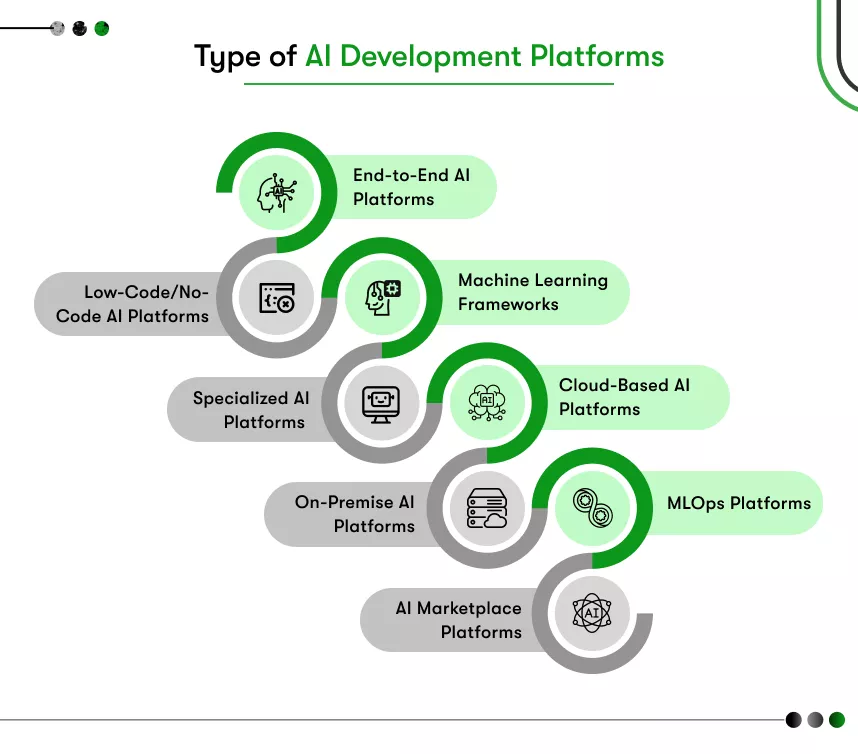
Here’s a list and a brief on the main types of AI platforms for app development.
- End-to-End AI Platforms support the entire lifecycle of AI development. It has got you covered from data preparation to training models, deploying the AI app, and monitoring it. Google Cloud AI, Microsoft Azure AI, and AWS SageMaker are the best examples of End-to-End AI platforms.
- Low-Code/No-Code AI Platforms offer user-friendly interfaces that allow non-technical users to build complex AI models using simple drag-and-drop tools or pre-built templates that can be further tailored to their needs. H2O AI, Google AutoML, and DataRobot are the best trendy examples of this platform.
- Machine Learning Frameworks are handy primarily for developers with coding expertise. These frameworks can be open-source or private frameworks providing libraries and tools for building custom AI models for developers. TensorFlow and PyTorch are the most suitable examples of machine learning frameworks.
- Specialized AI Platforms are specially tailored for specific AI domains, including NLP (i.e., natural language processing, computer vision, or generative AI solutions. These platforms are highly complex and need expertise when working with them. For instance, Hugging Face, which is based on the NLP concept, and RunwayML, which is based on generative AI. The AI use case of this platform is highly domain-specific and can utilize its maximum potential for AI business ideas.
- Cloud-based AI platforms are specifically hosted on cloud infrastructure. These platforms are not only highly scalable but also offer pre-built models and integration with other cloud services. A few well-known platforms are AWS services and IBM Watson. These platforms usually offer scalable AI solutions that help adjust the ROI of the AI app according to the enterprise’s datasets.
- On-Premise AI Platforms are designed for organizations that require AI development within their own infrastructure for security and compliance reasons. This AI platform is best for industries with strict data privacy regulations, such as healthcare and finance. One such example of an on-premise AI platform is H2O ai.
- MLOps Platforms— Machine learning operations platforms focus on the operational aspects of AI, like the deployment and lifecycle management of the application or project. For platforms like this, highly skilled ML and DevOps teams are required if you are planning on launching your idea, so you are advised to hire highly skilled AI developers who understand the goals of your application.
- AI marketplace platforms offer pre-built AI models, datasets, and various API for integration into your application, helping your application automate and perform accurately. This platform is best for businesses looking for ready-to-use AI solutions, as it offers a wide range of pre-built functions to suit your requirements. RapidAPI and Algorithmia are among the most popular platforms in this space.
Selecting the right type of AI development platform for your project entirely depends on your requirement and business goal. Understanding these categories will help you and your technical experts make right and informed decision for your project.
Key Features to Look for in an AI Development Platform
While it is exciting to understand the kind of AI platforms that are best for your application development, it is also crucial to have insights into how important it is to choose the right platform for your project goals, as each platform offers unique functionality and use cases. A platform suitable for AI app development needs to consist of this combination — balanced accessibility, scalability, and flexibility while addressing any technical and ethical considerations.

Let’s explore the key features to look for in AI development platforms.
1. Scalability and Deployment
Scalability is all about how a platform is able to handle increasing workloads, user demands, and data without compromising performance. On the other hand, deployment capabilities show how easily and flexibly the platform can integrate AI into an app.
AI projects often require processing large amounts of data or handling real-time inference. Thus, a scalable platform always ensures consistent performance while the deployment is smooth and flexible.
2. Integration with Popular AI Models and Tools
Integrating AI into an app involves much more than simply installing a few packages and calling it done. Using popular AI models and tools can significantly reduce development time, allowing developers to focus on customizing the application instead of building it from scratch.
This approach also accelerates the overall app development lifecycle and enhances compatibility. So, it is crucial to pick models that align well with your project goals.
3. Support for Coding and No-Code/Low-Code Development
The best part about No-code/low-code is its accessibility to AI development. This motivates other domain experts to contribute without deep programming knowledge, for instance, business analysts. When you investigate coding, it allows data scientists to customize complex models to a specific requirement.
4. Collaboration Features for Development Teams
When working on a project, collaboration features are of utmost demand as AI development often involves cross-functional teamwork for data preparation or model training. Collaboration features offer streamlined workflow, improved efficiency in a project, and most importantly, reduced error, which boosts the performance of the application.
5. Security and Compliance Considerations
No organization wishes to mess up when it comes to security and compliance considerations, as it’s about protecting crucial and sensitive data. So, this particular consideration is one of the crucial ones as it requires strong security measures to protect and prevent any sort of breaches.
Besides all the above considerations, you must also look for cost efficiency, community, and support. When selecting an AI development platform, you are primarily required to balance your project’s technical requirements, followed by team expertise and organisational constraints, as it will directly affect the project goal and budget.
Detailed Review of the 9 Best AI Development Platforms in 2026
Did you know that according to Stack Overflow’s 2025 reports, 52% of developers have agreed that the AI agents and other AI tools have had a positive effect on their productivity in daily task performance, helping them perform better.
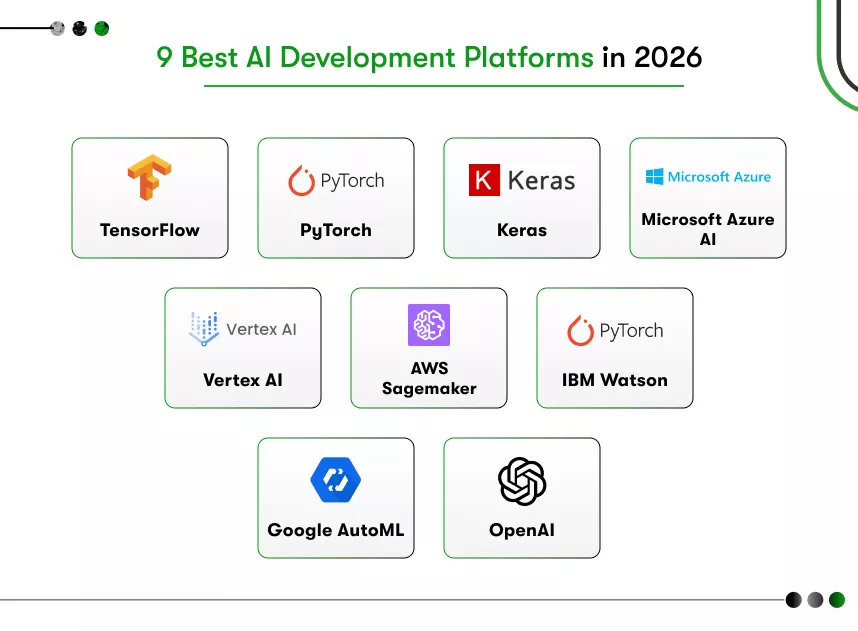
1. TensorFlow
TensorFlow is an open-source machine learning framework. It has a strong hold and emphasis on scalability, helping developers build the best AI applications possible.
Key Features and Unique Capabilities
Complete Set of Tools: TensorFlow comes with everything you need in one package. You get TensorBoard, TensorFlow Extended, and TensorFlow Lite. It is a perfect package if you want to see what’s happening with your models or to build full machine learning workflows, and then finally, when you want to run things on phones or smaller devices.
Ready-Made Models: Whether you are working with text (like BERT) or images (like ResNet), TensorFlow has literally got you covered, as TensorFlow Hub has tons of pre-built models you can use right away, which save you a lot of time and resources when building a project.
Best of Both Worlds: One thing that sets TensorFlow apart is the ability and flexibility you get in switching between eager execution and graph mode. Eager execution makes debugging way easier because you can clearly see what’s happening, and graph mode runs faster when you are actually deploying to test your model.
Target Users or Industries
Target users: Data scientists, researchers, and developers.
Industries: Healthcare, retail, and education.
Pricing Overview
TensorFlow is completely free and open-source. Costs arise from underlying infrastructure, but no licensing fees apply.
Pros and Cons
Pros:
- It is highly flexible and scalable for complex models.
- It has strong community support with extensive tutorials and documentation.
- It consists of seamless integration with Google Cloud for enterprise deployment.
Cons:
- It has a steep learning curve for beginners due to its low-level nature.
- It is time-consuming when debugging complex models.
- It requires extra setup and resources when you want to execute outside Google environments.
2. PyTorch
PyTorch was launched by Meta AI back in 2017. Like TensorFlow, this is also an open-source deep learning framework built on the Torch platform. It has mostly gained its popularity in academia as it offers dynamic computation graphs, and it is also quite dominant in research.
Key Features and Unique Capabilities
- Dynamic Neural Networks: PyTorch allows real-time changes to model architecture during execution, so you can make changes to a neural network on the fly while it’s actually running. This is perfect when you want to experiment with new things without having to start from scratch.
- Distributed Training: With PyTorch distributed training, you can literally scale up your training across multiple GPUs and machines. This comes in handy when you are dealing with large data or complex models in your project.
- Tools for Every Task: PyTorch is one of the ideal frameworks as it offers TorchVision, TorchAudio, and TorchServe for image, audio, and execution.
Target Users or Industries
Target Users: Researchers, developers, and students.
Industries: NLP, generative AI, and academia.
Pricing Overview
Free and open-source. Associated costs include hardware or cloud services for training.
Pros and Cons
Pros:
- It has a low learning curve and is an intuitive, Pythonic API.
- Due to its flexibility, it is excellent for experimentation and research.
- It has a strong community and native support for Apple’s M1/M-series chips.
Cons:
- It requires higher computational demands for large-scale production.
- It has fewer mature execution tools compared to TensorFlow.
- It might require significant power for computations.
3. Keras
Keras is a high-level neural networks API originally independent, but now integrated as tf.keras in TensorFlow. It’s designed for quick experimentation, making deep learning accessible.
Key Features and Unique Capabilities
Modular Design: Keras uses a modular design that feels intuitive – you literally stack layers, models, and training routines together like LEGO pieces. Want to add a new layer? Just snap it on. Need to try a different architecture? Rearrange the blocks. It’s that straightforward.
Multi-Backend Support: With Keras, you can run it on TensorFlow, PyTorch, or JAX, depending on what you prefer or what your project goals are. It adapts to almost every backend and offers better adaptability.
Pre-Trained Models: You can literally grab a proven model and tweak it for your specific task and skip weeks of training. Keras comes with built-in access to famous pre-trained models for like RestNet and more, and this makes transfer learning super easy.
Target Users or Industries
Target User: Beginners, developers, and small teams.
Industries: Startups in image classification, predictive analytics, and education.
Pricing Overview
Free and open-source as part of TensorFlow. No direct costs or infrastructure expenses are applied.
Pros and Cons
Pros:
- It is extremely beginner-friendly with simple, concise syntax.
- It offers fast prototyping and extensive documentation for better support.
- It offers scalability as it is seamlessly integrated with TensorFlow.
Cons:
- It holds limited flexibility for advanced, fine-grained control.
- It relies on backends like TensorFlow, so it inherits their limitations as well.
- When using this platform, GPU setup can be challenging on some platforms, like Windows or Ubuntu.
4. Microsoft Azure AI
Microsoft Azure AI is one of the best AI development platforms. It is an end-to-end cloud platform for AI development. As it has evolved from Azure Machine Learning, it integrates with Microsoft’s ecosystem easily. It also emphasizes more on enterprise security.
Key Features and Unique Capabilities
Ready-to-Use AI Services: Microsoft gives you prebuilt APIs for all the common stuff, such as vision, speech, language processing, and decision-making. The best part is that you can even tap into Azure OpenAI to use GPT models without building anything from scratch.
Creative AI Tools: Azure AI Foundry is best when you need your AI to work across different types of content, like text and images, as it brings multimodal capabilities to the table, including tools like GPT-image-1-mini for generating images.
Production-Ready Workflows: Besides offering enterprise-level security, the MLOps integration with Azure DevOps means you can set up automated pipelines for your work that can handle everything from training to deployment. So, your models move smoothly from development to production without manual handoffs and potential errors.
Target Users or Industries
Target User: Enterprises, developers, and data scientists.
Industries: Targets finance, healthcare, and retail for secure, scalable AI.
Pricing Overview
It has both free and paid pricing model, which differs based on the consumption-based pay model, and it is customisable.
Pros and Cons
Pros:
- It offers seamless integration with Microsoft tools such as Power BI and Teams.
- It consists of strong security and global scalability.
- It is a designer-driven tool for quick setup when necessary.
Cons:
- The pricing can escalate quickly for high-volume use as it’s customisable.
- It has a Steeper learning curve for non-Azure users, so initially, the user might find it difficult.
- It holds limited customization in low-code tools.
5. Google AI Platform/Vertex AI
Vertex AI is a unified ML platform that was re-branded from Google AI Platform back in 2021. Vertex AI builds on AutoML and Kubeflow, focusing on end-to-end workflows and adapting to all the features offered by both platforms.
Key Features and Unique Capabilities
Massive Model Library: Model Garden offers over 200 well-pretrained options, including Google’s own Gemini models, so whether you need something for images, text, or specialised tasks, there’s probably already a model available that’ll work for you.
Coding Made Easy: Vertex AI Workbench gives you a managed JupyterLab environment for collaborative coding with your team so that you can code together without worrying about setup or the infrastructure.
Understand Your Models: Built-in explainable AI tools help you peek under the hood and see why your model is making certain predictions. Also, you don’t have to be an ML expert; you just bring your data, and Vertex AI figures out the best model architecture for you.
Target Users or Industries
Target User: Data scientists and enterprises.
Industries: E-commerce, manufacturing, and tech R&D.
Pricing Overview
There are 2 pricing models: free tier and pay-per-use, which includes training and predictions.
Pros and Cons
Pros:
- It integrates UI for the full ML lifecycle.
- It offers excellent BigQuery integration for data prep.
Cons:
- With different services, the pricing model can become complex.
- The costs can be higher for custom training.
- It is limited to the Google Cloud ecosystem.
6. Amazon Web Services (AWS) – SageMaker
Amazon SageMaker is a fully managed machine learning service that integrates data prep, training, and execution, and it also integrates analytics and AI architectures.
Key Features and Unique Capabilities
Quick Start with Ready-Made Solutions: JumpStart offers pre-built models and solutions so you can literally jump start and give you a head start with pre-built models and complete solutions, which are packed and customisable.
All-in-One Workspace: SageMaker Studio is like your ML command center. It’s an integrated environment where your whole team can work together, share notebooks, track experiments, and manage everything in one place instead of juggling multiple tools.
Speed Without the Hassle: AWS includes over 10 built-in algorithms that are already optimized for performance, and it offers 10 times faster training compared to doing it yourself from scratch.
Target Users or Industries
Target User: ML engineers and enterprises.
Industries: Automotive, finance, and media.
Pricing Overview
Free tier: 250 hours/month for 3 months. Whereas the paid version is also available based on the pricing model you pick. These pricing models vary based on the deals offered by the organization.
Pros and Cons
Pros:
- SageMaker reduced ops overhead due to its end-to-end automation.
- It consists of deep AWS integration (S3, Lambda).
- It is specifically scalable for petabyte-scale data.
Cons:
- When maintaining it offers pricing complexity and potential for high costs, which can hinder the project budget.
- It is a steep learning curve for AWS beginners.
- It offers limited metric tracking during training sessions.
7. IBM Watson
IBM Watson watsonx focuses on open, multi-cloud AI with emphasis on flexibility, governance, and versatility.
Key Features and Unique Capabilities
Language and Data Analysis: IBM Watson is your perfect partner when it comes to building a great conversational chatbot or digging insights out of mountains of documents. For instance, it will come in handy when you’re dealing with enterprise-scale text data and need to make sense of it all.
Team-Friendly Development: watsonx Studio is best for collaboration, building, and testing because it can offer itself at best in these 3 things. When collaborating with the whole team, you can work on ML projects together and handle the tedious model building automatically.
Solves the Hard Problems: for instance, if you have a complex optimisation challenge— maybe you’re trying to figure out the best delivery routes or resource allocation? Watson’s Decision Optimisation tools will specifically deal with such brain-twisting problems and get them solved for you.
Target Users or Industries
Target Users: Enterprises and analysts.
Industries: Healthcare, finance, and customer service.
Pricing Overview
Starts at $0 for basic access. Then offers Lite, which is free for testing but paid after the trial. The enterprise model is custom and usage-based.
Pros and Cons
Pros:
- It offers multi-cloud flexibility and strong security.
- It is extremely user-friendly for non-experts with visual tools.
Cons:
- It offers high costs for the full range of features.
- Integration with IBM Watson can be time-consuming, depending on the complexity.
- IBM Watson has a smaller community compared to open-source alternatives.

8. Google AutoML
Google Cloud AutoML automates AI model creation using the transfer learning technique, and it also excels in custom vision and NLP models.
Key Features and Unique Capabilities
Zero Coding Required: Seriously, anyone can use it. You just have to upload your data, and AutoML handles the rest. It will be designed for people who have domain expertise, so you can focus on your problem, and it will figure out the rest of the technical stuff.
Smart Architecture Hunting: In the backend, it uses Neural Architecture Search to automatically find the best model structure for your specific task. So, you have an expert continuously testing different approaches to find what works best for your problem.
Does More with Less: Here’s the most interesting part about Google AutoML: even if you don’t have mountains of data, it can build highly accurate models and solid results for the data you provide.
Target Users or Industries
Target User: Non-ML experts, small businesses.
Industries: Retail, agriculture, and media.
Pricing Overview
Training: Paid Predictions: Paid units. Free tier: Limited hours for testing.
Pros and Cons
Pros:
- Accessible for beginners; quick model building.
- Leverages Google’s transfer learning for high quality.
- Integrates seamlessly with Google Cloud.
Cons:
- Opaque process; hard to understand/reproduce models.
- Pricing complexity for large datasets.
- Less control over hyperparameters.
9. OpenAI
OpenAI was founded in 2015. This platform offers APIs for advanced models like GPT-4o and o1. It is also a leader in generative AI with 700M+ weekly users. (OpenAI)
Key Features and Unique Capabilities
Multimodal Models: Initially, it supported only text format; however, with its upgraded version, it works with images and audio too, so you can build applications that understand and generate multiple types of content all in one go.
Build Smart Assistants: The agent SDK actually gives the ability to get things done, not just answer questions. It helps create AI agents that can handle complicated tasks and multitask at the same time.
Fine-Tuning: What could be better than productivity, right? With this feature, you can fine-tune the model with your own data, so it talks and thinks more like you to serve your needs and your specific problems. So, you can literally train the model to think like you and perform tasks with better precision.
Live Updates and Internet Access: The previous model was fed data, and the response depended on the data fed to the model. However, here’s where it gets interesting! The models can stream responses in real-time and actually search the web for current information.
Target Users or Industries
Target Users: Developers, startups, and enterprises.
Industries: Content creation, software dev, and research.
Pricing Overview
Tiered: Free; Plus; API pay-per-token. For Enterprise, it’s Custom.
Pros and Cons
Pros:
- It has the latest models with high accuracy.
- It is scalable and offers easy API integration.
- It also offers a free tier for experimentation for your project.
Cons:
- This could burn pockets as it has high costs for heavy API use.
- The Content filters offered by this platform can block valid requests, which might cause hindrance.
- It limits portability due to its dependency on OpenAI’s ecosystem.
How to Choose the Best AI Application Development Platform for Your Needs
51% of professional developers are using AI tools daily in the development cycle. So, this number implies how important it is to choose the best one for your project. Choosing the best AI application development platform depends on various factors such as your project requirements, technical expertise available, budget, and other execution needs.
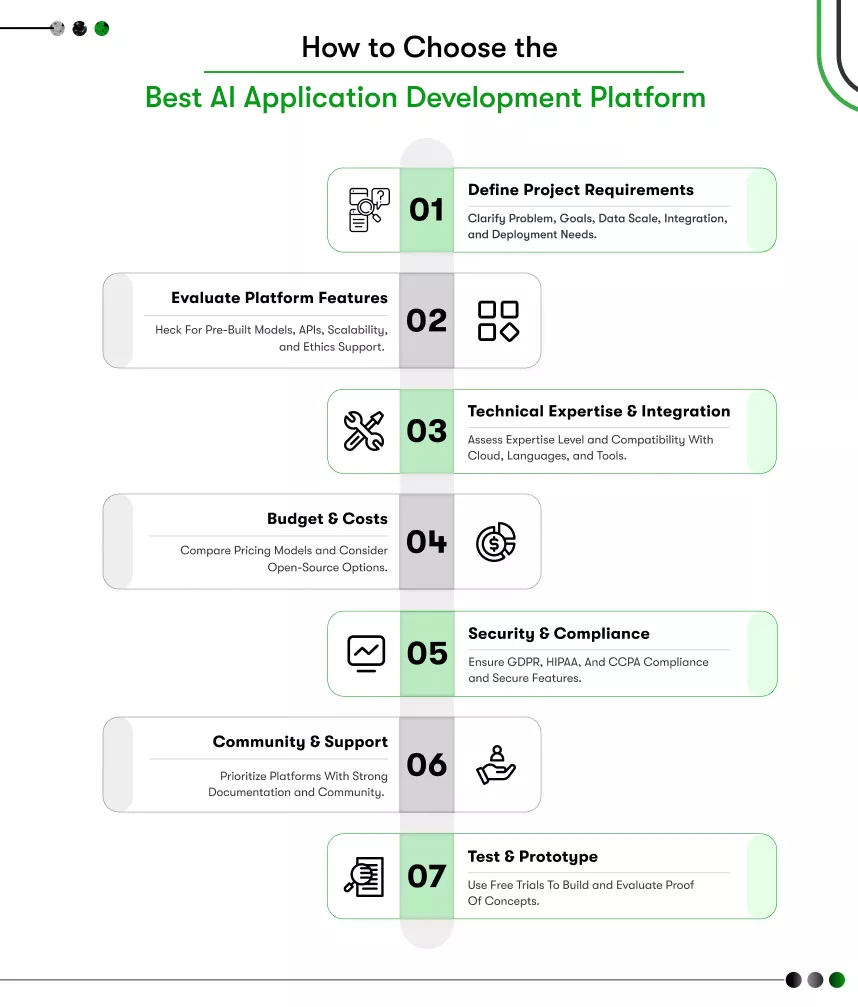
Here’s a brief structured evaluation for you to refer to the next time you want to select the most suitable platform:
1. Define Your Project Requirements
First and foremost, thing one must do is identify the specific problem you’re trying to solve and clarify the purpose and goals for your project. Thereafter, analyse the complexity and determine if you actually need automation or advanced models. Because this is where you’d know if you require AI development services or if you already have the resources for it.
Understand and list whether your application needs to handle large-scale data or user traffic, which will require handling large amounts of real-time data. Check if the platform can integrate with the existing systems and then decide if the app will run on cloud, on-premises, or edge devices only.
2. Evaluate Key Platform Features
After your requirements and goals are clear, the key platform features are required for your project. Pre-built models and APIs, Custom model development, No-code/Low-code options, Data handling, scalability, explainability, and ethics. Evaluate and list the key features to match and find the top platform for AI development. You need to ensure the platform supports your data or the complexity of the project for better architecture and infrastructure.
3. Consider Technical Expertise and Integration
After you have evaluated the key platform’s features, evaluate the technical expertise required to actually begin the project. Do you require beginner-friendly, developer-friendly, or hybrid options? Having this sorted helps you understand more about your resources. It will help you understand and conclude whether you can take on the project alone or need the guidance of generative AI development company.
Thereafter, ensure the platforms integrate with your preferred cloud provider or have powerful tool support and compatibility with programming languages. Then comes the third-party integration, where you look for support tools like Docker and Power BI.
4. Budget and Cost Considerations
Budget is the most crucial step when you are deciding on the best AI development platform for your project. You should compare pay-as-you-go, subscription, or free-tier options. Then you should account for your costs related to data storage and model training. You have other options as well— the open-source options like TensorFlow or Hugging Face are free, but they might also require more infrastructure investment.
5. Security and Compliance
Not only for enterprises, but if you are deciding to launch any project, security and compliance are the two most core and crucial elements for your project to succeed. So, ensure the platforms comply with regulations like GDPR, HIPAA, and CCPA when you are handling sensitive data. Look for encryption, access controls, and secure APIs for your project.
6. Community and Support
This is a subtle but a saviour in your difficult time. Any AI application development platform that has extensive or detailed documentation and community support will come in handy to the developer community, which then accelerates innovation in the project.
7. Test and Prototype
Lastly, when you have clearly considered all the above points, try and ask for free trials before adapting to the platform completely and build proof of concepts, and then evaluate performance accordingly to grow your project.
Conclusion
In the end, it’s essential that you understand your project’s requirements and choose the best AI development platform for app development and hire the best AI developers for your project. All the AI development platforms offer unique features for your project, so choose it wisely to understand whether your solution requires expert help or can be handled through the AI platforms for app development.
The AI development landscape offers secure solutions for building a power-packed AI platform for application development. By carefully evaluating all the factors and understanding the latest AI development platforms available for your project, you can confidently choose the top and best option to build AI chatbots app that aligns with your business goals. With such an increasing curve in the AI development market, this is the best time to join the AI trend, gain higher ROI, and offer your users smarter, faster, and more personalized solutions.
If you are ready to transform your idea into an intelligent and high-performing application, you can Contact Kody Technolab for expert AI development services that bring your vision to life.
FAQ
1. What are the best AI development platforms for building AI applications in 2025?
The top AI development platforms in 2025, which will continue to top in 2026, include TensorFlow, PyTorch, Microsoft Azure AI, Google Vertex AI, AWS SageMaker, IBM Watson, Google AutoML, and OpenAI. Each offers unique strengths and weaknesses.
2. How do I choose the best AI development platform for my project?
It’s simple but requires careful analysis. You define your project goals, assess technical expertise, and have a detailed evaluation of all the features. Thereafter, match the goal and requirement, list the budget and platform you think is suitable, and choose which set is best for your project goals.
3. What are the top platforms for AI app development for startups in 2025?
It depends on the startup goals and requirements. Although tools like Google AutoML and H2O ai, and no-code/low-code AI app development are some platforms that’ll benefit startups, as they are cost-effective and scalable.
4. What are the key features to look for in an AI application development platform?
Scalability, flexibility, integration, and support are the key features you should initially be looking for in an AI application development platform. Once you have listed the AI development platform experiment and progress with your requirement.
5. Are there free AI development platforms available for app development?
Yes, open-source platforms are free to use. TensorFlow, PyTorch, and Hugging Face are some of the examples of powerful AI app development. Google Cloud AI and AWS SageMaker also offer free tiers for testing, but the price increases as your requirements increase.

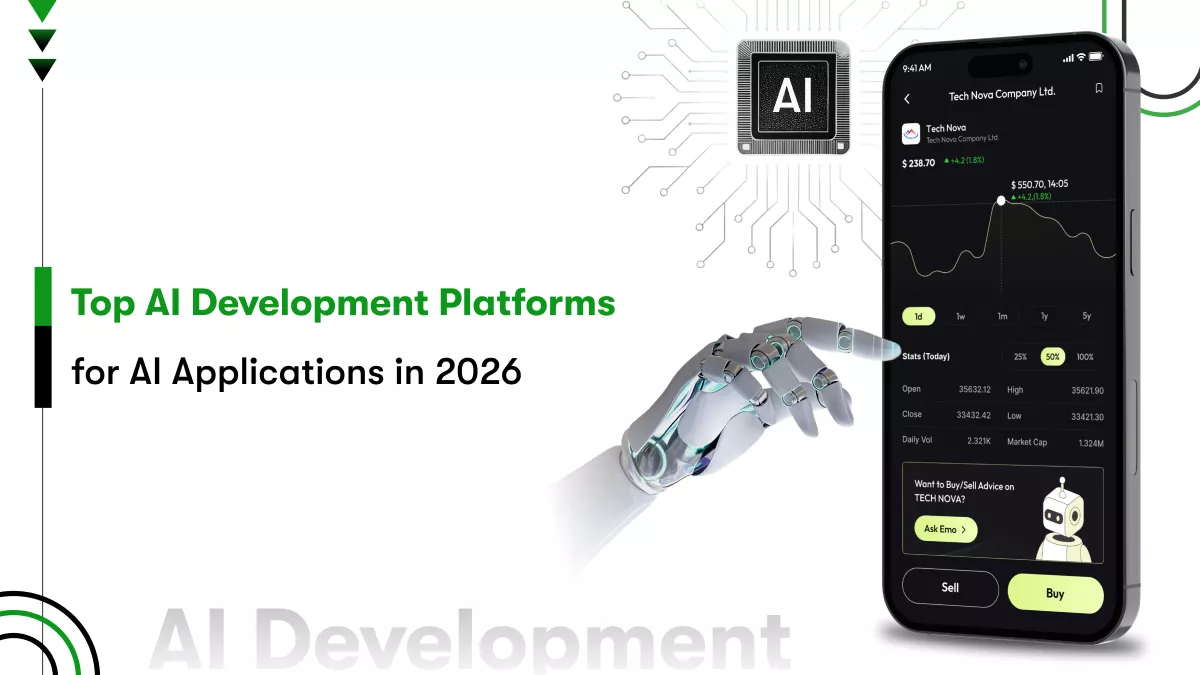

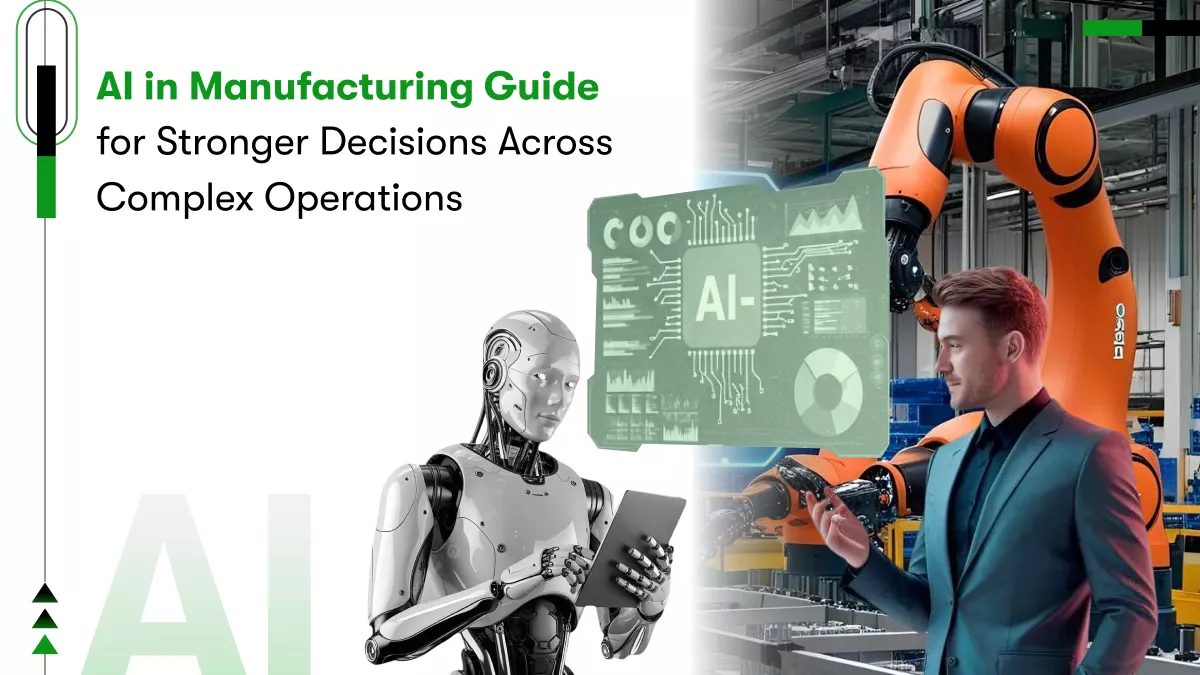
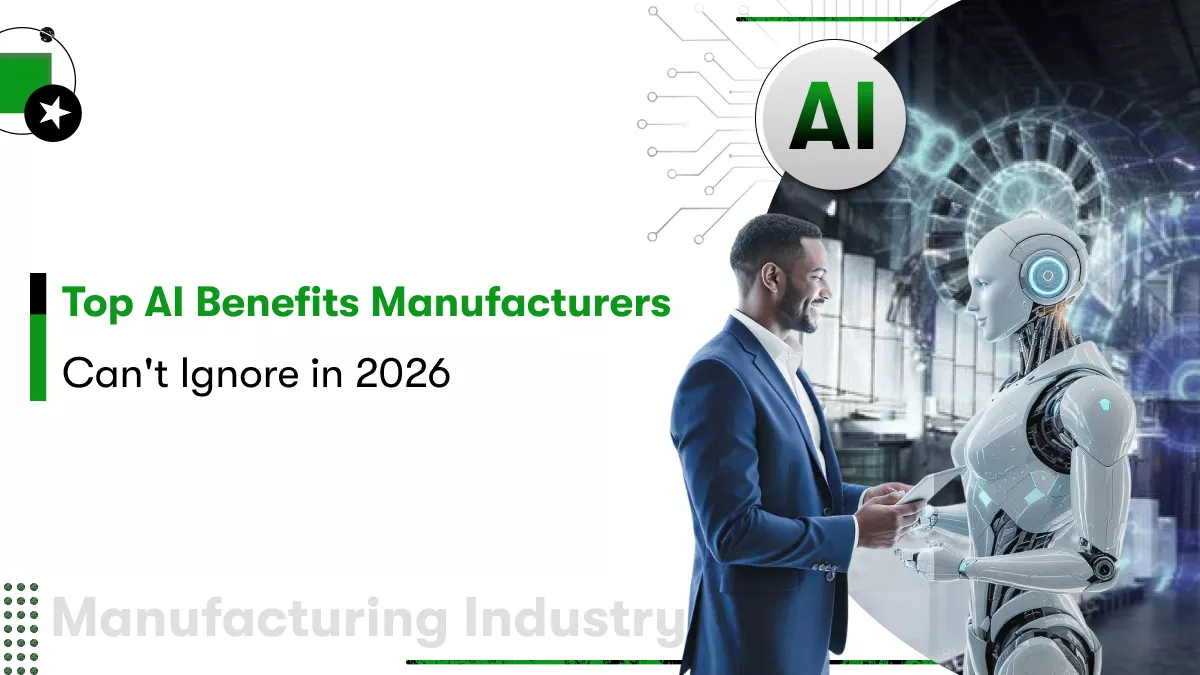
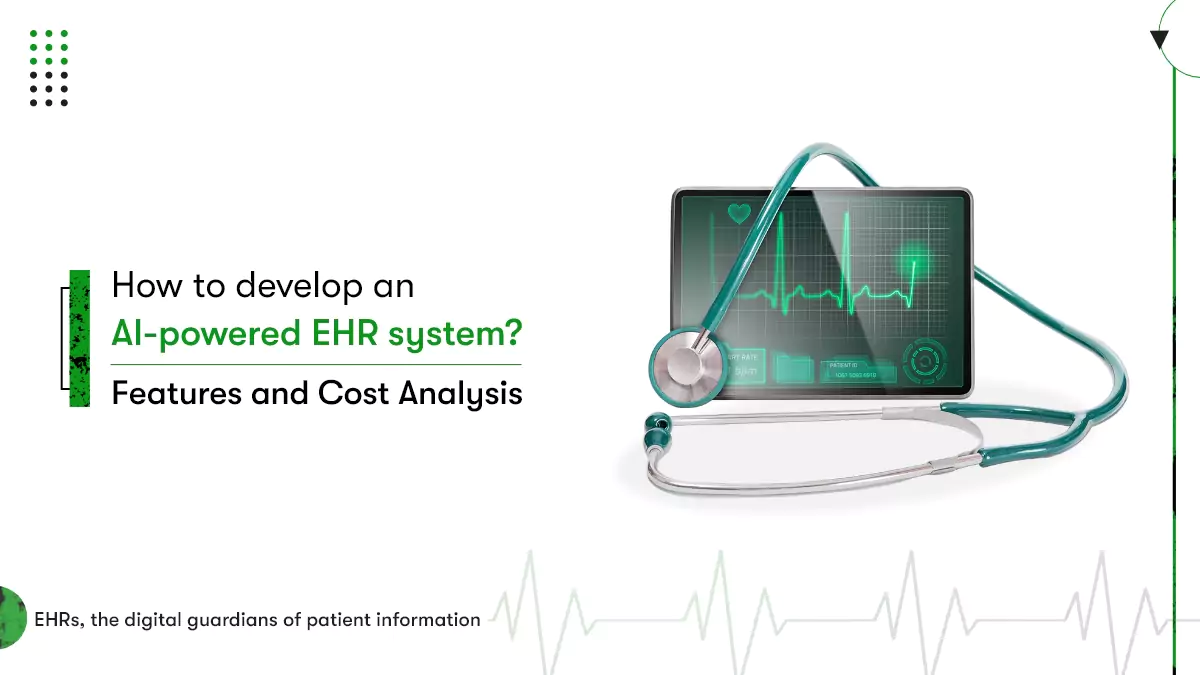







 Contact Information
Contact Information